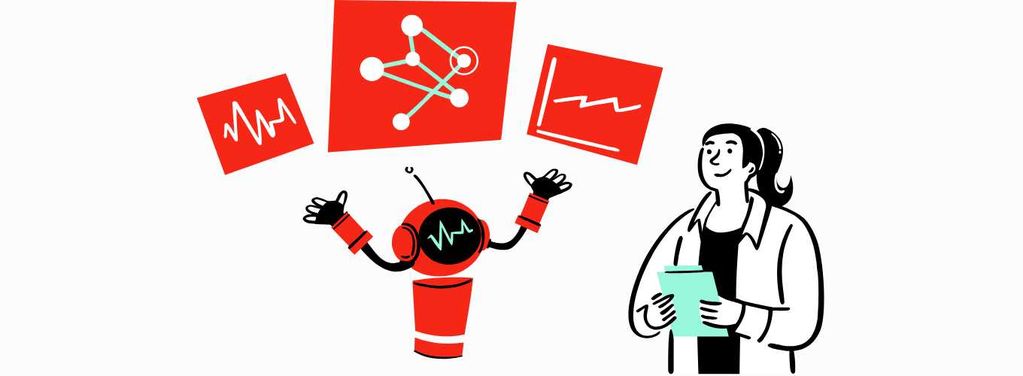AI in the worklplace: an ongoing evolution

Will you be replaced in the coming years by artificial intelligence in your position? Theoretically, it is possible. But let’s be realistic: the probability is next to none. The AI currently being developed and used in businesses primarily aims to be a support or aid to existing work. Therefore, AI should first be considered as a crutch rather than a “great replacement.”
2025-2030: the ongoing revolution
“In fact, AI is already everywhere in our daily lives and in businesses,” points out Baptiste Fosséprez, the CEO of PEPIte, a company specializing in AI. “This is because we are not always aware of it or because we imagine artificial intelligence as seen in movies, with robots taking over. But in our daily lives, we are constantly confronted with artificial intelligence. Whether it’s searching on Google, Netflix recommendations, our Facebook news feed, or the succession of videos on TikTok based on our preferences, AI is already present in our everyday lives. Many companies use and develop AI to improve their profitability or efficiency. That is the whole interest of this ongoing revolution.”
What can we expect in the upcoming years?
It’s important to distinguish reality from fantasy. Experts all agree that the next 10 years will be genuinely transformative. But everything will happen in stages. “By 2030, we won’t have multifunctional humanoid robots replacing humans. We need to imagine our relationship with AI as a wave, not a tsunami. The collective imagination thinks that the world will change overnight. One day we will wake up and we will be in another reality. This obviously isn’t how it works. There are trials and errors in technology. Changes happen progressively, in small waves. Things advance a bit, then retreat, and then return. Our world integrates these novelties over time,” concludes Baptiste Fosséprez.
The purpose of AI in the workplace
AI in business encompasses dozens of possibilities. Of course, there are the software and applications already mentioned, but there are also very concrete aspects. Here are 5 of the most common fields of application today:
- Increased automation: AI enables companies to automate more and more repetitive tasks and processes, reducing operational costs and improving efficiency.
- Improved customer experience: Chatbots, recommendation systems, and customer data analysis allow companies to personalize their interactions with customers, enhancing their satisfaction and loyalty.
- AI-assisted decision-making: AI tools provide real-time analysis and relevant insights to help leaders make more informed decisions and anticipate market trends.
- Supply chain optimization: AI is used to forecast demand, manage inventory, and improve logistics, allowing companies to reduce costs and optimize their operations.
- Personalization of products and services: Companies can use AI to develop more personalized products and services based on individual customer preferences.
The risks of AI in the workplace
For any change in business, there are several precautions to take. One doesn’t evolve a model without being prepared or knowing what will be gained and lost.
Here are 4 real risks associated with the presence of AI in companies:
- The use of AI involves the collection and analysis of large amounts of data. The security and confidentiality of this data are essential, as companies are vulnerable to data breaches and cyberattacks. We all know the GDPR 🙂
- Technological dependence: companies that rely too heavily on AI may become dependent on this technology, making them vulnerable in case of system failure, power outages, or other technical issues.
- Ethics and accountability: companies must face complex ethical questions related to the use of AI, especially regarding accountability in decisions made by autonomous systems. In short: who is responsible for what?
- Cost and complexity: implementing AI systems can be costly and complex. Companies must invest in training their staff and in the infrastructure necessary to fully leverage AI.
It is also essential to consider the dual impact that AI can have on employees:
On one hand, the impact on creativity and intuition: AI can be very efficient for repetitive and analytical tasks, but it can also reduce the place of human creativity and intuition in decision-making. This is a genuine point of concern.
On the other hand, the psychological impact and resistance to change: employees may resist the integration of AI in the workplace due to fears related to job loss, increased surveillance, or other concerns.
An HR tool for recruitment
In July, a ManpowerGroup study explained how the adoption of new technologies is transforming recruitment practices and human resource management.
AI can contribute to the recruitment process in several ways.
- First level: in a recruitment process, AI already helps in writing job postings, acting as headhunters for specific profiles on networks like LinkedIn, and reaching out to future talents…
- Second level: once contact is established, the use of conversational AI tools like ChatGPT allows candidates to ask questions and learn more about the company, and vice versa.
- Third level: the use of Machine Learning (ML). This involves statistical learning that allows for increasingly accurate predictions based on data. During an interview, for instance, the candidate may answer questionnaires or explain certain situations, and AI will identify their strengths, weaknesses, and potential…
A robot, CEO of a company?
In Poland, the alcoholic beverage company Dictador is led by Mika, a humanoid robot equipped with AI. This is the first time an AI robot has been used in such a responsible position.
Mika helps identify potential customers and selects artists to design bottles for the products sold by Dictador. The advantage, according to the Polish company, is that “Mika is devoid of any personal prejudice, ensuring strategic choices that prioritize the best interests of the organization.”
Mika will not fire any of its employees, as the most important decisions of Dictador are still made by humans.
To see Mika in a meeting, click here
Is AI a danger to current jobs?
The question of job destruction by machines has existed for a long time. Since the industrial revolution, in fact. In recent years, many jobs have been “destroyed” by machines. But automation, robotization, and digitalization have also “created” new jobs. There were no social media managers, influencers, or vloggers in the year 2000. According to the International Labour Organization study on the subject, generative artificial intelligence is expected to create more jobs than it destroys. However, one point of attention: the study reveals that the potential effects of generative AI are likely to differ significantly for men and women, with the share of women’s jobs being more than twice as likely to be affected by automation due to the overrepresentation of women in office jobs, especially in high- and middle-income countries.
Check out the entire report here.
Conclusion: AI isn’t out to get us
Embrace evolution but beware of the risks. AI is here to stay, and it might become very useful in years to come. Or maybe, it already is in your line of work. Check out the playing field while being cautious of the possible risks AI might bring.
Did you know ?
- News16 December, 2025All you need to know when spending your Edenred vouchers at Auchan!

- News15 December, 2025Why is there a daily cap on meal vouchers in Luxembourg?

- News10 December, 2025Volunteering: the collective in service of the common good
